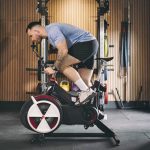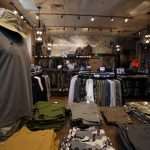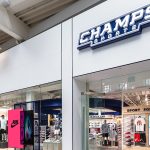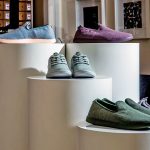Helped by a focus on reducing promotions in its U.S. stores along with a small comp store sales gain, Foot Locker, Inc. earned $6 million, or 4 cents a share, in the second quarter against break-even results in the year-ago period. Earnings exceeded the Street's consensus expectation by a penny per share. A 240 basis point improvement in gross margin helped division profit of its combined business segments nearly triple versus the year-ago period.
Same-store sales rose 2.5% – its first consecutive quarter of comp gains since 2005. Total sales grew 1.3% excluding currency changes. On a conference call with analysts, management also indicated that sales were “off to a good start in August with strong sales results” for the first two and a half weeks of the month.
For U.S. operations, combined comps increased at a rate slightly higher than its overall 2.5% consolidated increase, fueled by gains in both footwear and apparel.
Athletic footwear sales in the U.S. increased low- to mid-single digits. “Solid” sales gains were generated in both men's and women's. Average footwear selling prices increased low-double digits, reflecting a lower markdown rate and a shift towards more premium-priced footwear. Transactions declined mid-single digits. U.S. stores “made a significant contribution” to the total company profit gain.
“While a decline in transactions is not unusual when consumers trade up to higher priced merchandise, we believe that increasing the rate at which we convert store traffic into increased sales is a significant long-term opportunity for our company,” said company Chairman and CEO Ken Hicks on the call.
In men's, “very strong” increases were seen in technical and lightweight running shoes. While basketball remains “a very powerful” part of Foot Locker's assortment, the U.S. chain is seeing “more young customers broadening their interest to include running shoes which are becoming more important. We also saw a continuation of a men's fashion trend shift from the casual and lifestyle footwear assortments to the running category during the quarter.”
The women's improvement was led by the continued growth in toning shoes, led by Reebok and Skechers, and a significant increase in running, most notably from styles from Nike, Asics and Puma.
Looking ahead, Hicks said basketball should be supported by some “great launches” from Nike, and excitement around Lebron James joining the Miami Heat.
Hicks also noted that the World Basketball Festival, just held in New York and sponsored by Nike, “created significant excitement, and the shoes that we had set up for that did very well.”
Hicks expects toning's growth rate will slow but still remain an ongoing category. Said Hicks, “I think the growth curve will flatten out a bit as its spread, and it will become a staple in the overall assortment. And over time, we will see which type of toning shoe the customer tends to gravitate more, but right now it's a good business.”
The category is being supported by people buying a second pair in a different color to match an outfit. In other cases, people are upgrading to the next reiteration of the model or trying a different brand. But Hicks said a big benefit is the trend is bringing a new, previously inactive, customer to the store. Said Hicks, “The reason that we really like toning is because it's gotten people more active, and that gets them buying more athletic shoes.”
Hicks also noted that even without toning, “women's would still be a good business,” with particular strength in technical running as well as in apparel.
Overall U.S. apparel comps increased low-single digits with gains in both men's and women's. Sales of accessories increased mid-single digits.
Hicks noted that apparel marked “meaningful sequential” improvement, given that the category declined low-single digit in Q1 and fell double digits in Q4 last year. He attributed the apparel improvement to better offerings from brands such as Nike, Adidas and Under Armour. Events such as the World Cup, the World Basketball Festival and Lebron James shifting teams helped licensed sales. Private label is also “improving significantly” by upgrading performance aspects, with particular success in women's.
He estimated that Foot Locker is about halfway to readjusting its overall in-store assortments.
Internationally, sales in total increased low single digits and profits increased low double digits. Foot Locker Europe's comp gain was likewise slightly higher than the 2.5% consolidated rate with solid increases in footwear and apparel. Canada comps declined low single digits although an improving merchandising margin rate helped drive a low-double digit division profit gain. Asia Pacific decreased mid single digits after increases in high single digits during last year's Australia government stimulus package program.
Direct-to-customer, which includes store websites and Eastbay, saw comps increase low-single digits for the quarter. Strong double digit sales gains were generated through Internet sales aligned with its store brands.
The 230 basis point gross margin gain reflected a 210-basis point improvement in merchandise margin, due to lower markdowns, reduced inventory shortages, and favorable mix shifts toward higher margin apparel. On a constant currency basis, Q2 inventories were 4.4% lower than last year, versus a constant currency sales increase of 1.3%.
Foot Locker forecast Q3 comp growth in the low- to mid-single-digits on a percentage basis. Margins are expected to improve by 100 to 150 basis points.
Asked what's driving the faster-than-expected returns on its turnaround efforts, Hicks cited the significant benefit from broadening its customer base and assortment, partly driven by the running and toning momentum. But some marketing is helping to support and differentiate the different banners.
“I would like to be further along on the store environment, but the investment…is something that we are going to take our time a bit to make sure that we do it right,” said Hicks.















